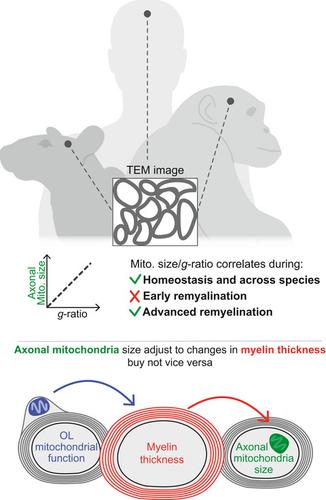当前位置:
X-MOL 学术
›
J. Neurosci. Res.
›
论文详情
Our official English website, www.x-mol.net, welcomes your
feedback! (Note: you will need to create a separate account there.)
Axonal mitochondria adjust in size depending on g‐ratio of surrounding myelin during homeostasis and advanced remyelination
Journal of Neuroscience Research ( IF 2.9 ) Pub Date : 2020-12-25 , DOI: 10.1002/jnr.24767 Benjamin V Ineichen 1 , Keying Zhu 1 , Karl E Carlström 1, 2
Journal of Neuroscience Research ( IF 2.9 ) Pub Date : 2020-12-25 , DOI: 10.1002/jnr.24767 Benjamin V Ineichen 1 , Keying Zhu 1 , Karl E Carlström 1, 2
Affiliation

|
Demyelinating pathology is common in many neurological diseases such as multiple sclerosis, stroke, and Alzheimer's disease and results in axonal energy deficiency, dysfunctional axonal propagation, and neurodegeneration. During myelin repair and also during myelin homeostasis, mutual regulative processes between axons and myelin sheaths are known to be essential. However, proficient tools are lacking to characterize axon‐myelin interdependence during (re)myelination. Thus, we herein investigated adaptions in myelin sheath g‐ratio as a proxy for myelin thickness and axon metabolic status during homeostasis and myelin repair, by using axonal mitochondrial size as a proxy for axonal metabolic status. We found that axons with thinner myelin sheaths had larger axonal mitochondria; this was true for across different central nervous system tracts as well as across species, including humans. The link between myelin sheath thickness and mitochondrial size was temporarily absent during demyelination but reestablished during advanced remyelination, as shown in two commonly used animal models of toxic demyelination. By further exploring this association in mice with either genetically induced mitochondrial or myelin dysfunction, we show that axonal mitochondrial size adjusts in response to the thickness of the myelin sheath but not vice versa. This pinpoints the relevance of mitochondrial adaptation upon myelin repair and might open a new therapeutic window for remyelinating therapies.
中文翻译:

在体内平衡和高级髓鞘再生过程中,轴突线粒体的大小取决于周围髓鞘的 g 比
脱髓鞘病理在许多神经系统疾病中很常见,例如多发性硬化症、中风和阿尔茨海默病,并导致轴突能量缺乏、轴突传播功能障碍和神经变性。在髓鞘修复和髓鞘稳态期间,轴突和髓鞘之间的相互调节过程被认为是必不可少的。然而,缺乏熟练的工具来表征(再)髓鞘形成过程中轴突 - 髓鞘的相互依赖性。因此,我们在此研究了髓鞘g-ratio 作为体内平衡和髓鞘修复期间髓鞘厚度和轴突代谢状态的代表,通过使用轴突线粒体大小作为轴突代谢状态的代表。我们发现髓鞘较薄的轴突具有较大的轴突线粒体;这对于不同的中枢神经系统以及包括人类在内的物种都是如此。髓鞘厚度和线粒体大小之间的联系在脱髓鞘过程中暂时不存在,但在高级髓鞘再生过程中重新建立,如两种常用的毒性脱髓鞘动物模型所示。通过在基因诱导的线粒体或髓鞘功能障碍的小鼠中进一步探索这种关联,我们表明轴突线粒体大小会根据髓鞘的厚度进行调整,但反之则不然. 这指出了线粒体适应与髓鞘修复的相关性,并可能为髓鞘再生疗法打开一个新的治疗窗口。
更新日期:2021-01-29
中文翻译:

在体内平衡和高级髓鞘再生过程中,轴突线粒体的大小取决于周围髓鞘的 g 比
脱髓鞘病理在许多神经系统疾病中很常见,例如多发性硬化症、中风和阿尔茨海默病,并导致轴突能量缺乏、轴突传播功能障碍和神经变性。在髓鞘修复和髓鞘稳态期间,轴突和髓鞘之间的相互调节过程被认为是必不可少的。然而,缺乏熟练的工具来表征(再)髓鞘形成过程中轴突 - 髓鞘的相互依赖性。因此,我们在此研究了髓鞘g-ratio 作为体内平衡和髓鞘修复期间髓鞘厚度和轴突代谢状态的代表,通过使用轴突线粒体大小作为轴突代谢状态的代表。我们发现髓鞘较薄的轴突具有较大的轴突线粒体;这对于不同的中枢神经系统以及包括人类在内的物种都是如此。髓鞘厚度和线粒体大小之间的联系在脱髓鞘过程中暂时不存在,但在高级髓鞘再生过程中重新建立,如两种常用的毒性脱髓鞘动物模型所示。通过在基因诱导的线粒体或髓鞘功能障碍的小鼠中进一步探索这种关联,我们表明轴突线粒体大小会根据髓鞘的厚度进行调整,但反之则不然. 这指出了线粒体适应与髓鞘修复的相关性,并可能为髓鞘再生疗法打开一个新的治疗窗口。











































 京公网安备 11010802027423号
京公网安备 11010802027423号